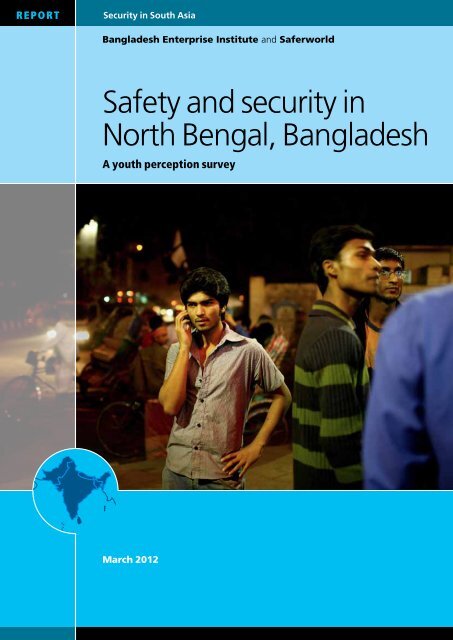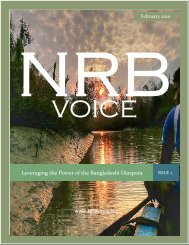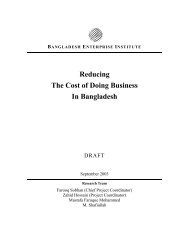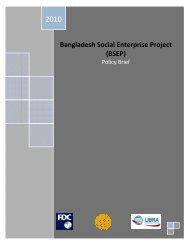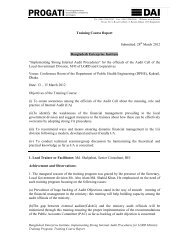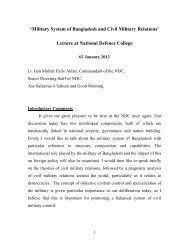Safety and security in North Bengal, Bangladesh - Saferworld
Safety and security in North Bengal, Bangladesh - Saferworld
Safety and security in North Bengal, Bangladesh - Saferworld
You also want an ePaper? Increase the reach of your titles
YUMPU automatically turns print PDFs into web optimized ePapers that Google loves.
<strong>Safety</strong> <strong>and</strong> <strong>security</strong><strong>in</strong> <strong>North</strong> <strong>Bengal</strong>,<strong>Bangladesh</strong>A youth perception survey<strong>Bangladesh</strong> Enterprise Institute, <strong>Bangladesh</strong>, <strong>and</strong> SAFERWORLD, ukmarch 2012
AcknowledgementsThis report represents an analysis of primary <strong>and</strong> secondary research conductedbetween November 2010 <strong>and</strong> April 2011 by the <strong>Bangladesh</strong> Enterprise Institute (BEI)with technical <strong>and</strong> f<strong>in</strong>ancial support from <strong>Saferworld</strong>. This report was prepared byMohammad Humayun Kabir <strong>and</strong> Dipta Chakma at BEI with comments from RosyCave, Chamila Hemmathagama <strong>and</strong> Neila Husa<strong>in</strong> at <strong>Saferworld</strong>. Special thanks goto Faiz Sobhan, Asish Banik, Ayreen Khan, Sumaiya Nour <strong>and</strong> Moynul Haque fortheir advice <strong>and</strong> contributions to this report. Thanks are also due to Eleanor Gordonfor edit<strong>in</strong>g the report. F<strong>in</strong>ally, thanks goes to all those people liv<strong>in</strong>g <strong>in</strong> <strong>North</strong> <strong>Bengal</strong>,<strong>Bangladesh</strong>, officials from the Government of <strong>Bangladesh</strong>, <strong>security</strong> service providers<strong>and</strong> civil society members for their contributions <strong>and</strong> support <strong>in</strong> conduct<strong>in</strong>g thisresearch.BEI <strong>and</strong> <strong>Saferworld</strong> are grateful to the Royal M<strong>in</strong>istry of Foreign Affairs, Governmentof Norway, for its f<strong>in</strong>ancial support for this project.AcronymsBDHSBEIBIPSSFGDIEDJMBKIINGOSAARCSALWSPSSUK<strong>Bangladesh</strong> Demographic Health Survey<strong>Bangladesh</strong> Enterprise Institute<strong>Bangladesh</strong> Institute of Peace <strong>and</strong> Security StudiesFocus group discussionImprovised explosive deviceJamaat-ul-Mujahideen <strong>Bangladesh</strong>Key <strong>in</strong>formant <strong>in</strong>terviewNon-governmental organisationSouth Asian Association for Regional CooperationSmall arms <strong>and</strong> light weaponsStatistical Package for the Social SciencesUnited K<strong>in</strong>gdom© BEI <strong>and</strong> <strong>Saferworld</strong>, March 2012. All rights reserved. No part of this publication maybe reproduced, stored <strong>in</strong> a retrieval system or transmitted <strong>in</strong> any form or by any meanselectronic, mechanical, photocopy<strong>in</strong>g, record<strong>in</strong>g or otherwise, without full attribution.<strong>Saferworld</strong> welcomes <strong>and</strong> encourages the utilisation <strong>and</strong> dissem<strong>in</strong>ation of the material<strong>in</strong>cluded <strong>in</strong> this publication. Please contact <strong>Saferworld</strong> if you would like to translatethis report.
Divisions of <strong>Bangladesh</strong>RANGPURINDIARAJSHAHI DHAKA SYLHETDhakaKHULNACHITTAGONGBARISALBAY OF BENGALMYANMARThis map is <strong>in</strong>tended for illustrative purposes only. Borders, names <strong>and</strong> other features are presented accord<strong>in</strong>g to the best of<strong>Saferworld</strong>'s knowledge. <strong>Saferworld</strong> takes no position on whether this representation is legally or politically valid.
Districts <strong>in</strong> Rajshahi <strong>and</strong> RangpurPanchagarhThakurgaonLalmonirhatNilphamariKurigramD<strong>in</strong>japurRANGPURRangpurINDIANaogaonJoypurhatGaib<strong>and</strong>haNawabganjRAJSHAHIBograRajshahiNatoreSirajganjDHAKAPabnaKHULNADhakaThis map is <strong>in</strong>tended for illustrative purposes only. Borders, names <strong>and</strong> other features are presented accord<strong>in</strong>g to the best of<strong>Saferworld</strong>'s knowledge. <strong>Saferworld</strong> takes no position on whether this representation is legally or politically valid.
Forewordthere is an <strong>in</strong>creas<strong>in</strong>g recognition that a secure environment is aprecondition for development. Armed violence, <strong>in</strong><strong>security</strong> <strong>and</strong> poverty are often<strong>in</strong>ter-connected <strong>and</strong> not only underm<strong>in</strong>e <strong>in</strong>dividual <strong>security</strong> but also impedeprogress towards the eradication of poverty. Over the past decade, there has been aperceived <strong>in</strong>crease <strong>in</strong> <strong>in</strong>cidents of violence, <strong>in</strong>clud<strong>in</strong>g armed violence, <strong>in</strong> <strong>North</strong> <strong>Bengal</strong>,<strong>Bangladesh</strong>. The prevalence of armed groups <strong>and</strong> <strong>in</strong>cidences of violence <strong>and</strong> crimethreaten community safety <strong>and</strong> <strong>security</strong> <strong>in</strong> a region which has often been identified asvulnerable to <strong>in</strong>stability <strong>and</strong> <strong>in</strong><strong>security</strong>.However, there have been no recent empirical studies that have explored perceptionsof young women <strong>and</strong> men <strong>in</strong> <strong>North</strong> <strong>Bengal</strong> regard<strong>in</strong>g safety <strong>and</strong> <strong>security</strong> <strong>and</strong> futureoptions for creat<strong>in</strong>g a secure <strong>and</strong> stable region. Perceptions of the youth are importants<strong>in</strong>ce they are the future leaders who will determ<strong>in</strong>e the future course of their country<strong>in</strong> both ideological <strong>and</strong> socio-political development terms. The pr<strong>in</strong>cipal aim of thisstudy is to develop a better underst<strong>and</strong><strong>in</strong>g of perceived <strong>and</strong> actual trends <strong>in</strong> <strong>in</strong><strong>security</strong><strong>and</strong> ways to address them as seen from the hearts <strong>and</strong> m<strong>in</strong>ds of young people <strong>in</strong> <strong>North</strong><strong>Bengal</strong>.I would like to thank Rosy Cave, Chamila Hemmathagama, Neila Husa<strong>in</strong> <strong>and</strong> EvelynVancollie at <strong>Saferworld</strong> for their advice <strong>and</strong> contributions to this project. At BEI,thanks go to Humayun Kabir, Faiz Sobhan, Dipta Chakma, Asish Banik, AyreenKhan, Moynul Haque <strong>and</strong> Sumaiya Nour who have made this project possible bycontribut<strong>in</strong>g their time, effort <strong>and</strong> enthusiasm.Farooq SobhanPresidentBEI
Executive summary■■■■this report presents the f<strong>in</strong>d<strong>in</strong>gs of field research undertaken <strong>in</strong><strong>Bangladesh</strong> between November 2010 <strong>and</strong> April 2011 <strong>in</strong>to youth 1 perceptions of safety<strong>and</strong> <strong>security</strong> <strong>in</strong> <strong>North</strong> <strong>Bengal</strong> <strong>in</strong> <strong>Bangladesh</strong>, <strong>in</strong>clud<strong>in</strong>g concerns associated withviolent extremism. 2This study addresses safety <strong>and</strong> <strong>security</strong> <strong>in</strong> <strong>North</strong> <strong>Bengal</strong> because it has often beenperceived as be<strong>in</strong>g a region most vulnerable to <strong>in</strong><strong>security</strong> <strong>and</strong> to the <strong>in</strong>fluence ofextremist groups. Some research has <strong>in</strong>dicated that underprivileged, unemployedyouths are the most likely to be targeted for recruitment by extremist groups. 3The research presented <strong>in</strong> this report focused on ascerta<strong>in</strong><strong>in</strong>g the views of youngwomen <strong>and</strong> men on safety <strong>and</strong> <strong>security</strong> issues, recognis<strong>in</strong>g that respond<strong>in</strong>g totheir perceptions, aspirations <strong>and</strong> concerns may prove the most beneficial <strong>in</strong>terms of identify<strong>in</strong>g ways <strong>in</strong> which to improve safety <strong>and</strong> <strong>security</strong> <strong>in</strong> <strong>North</strong> <strong>Bengal</strong><strong>and</strong> m<strong>in</strong>imise the threat of extremist groups. It is also hoped that some of therecommendations made by the research participants <strong>and</strong> emanat<strong>in</strong>g from theresearch, <strong>in</strong> respect of how to improve <strong>security</strong> <strong>in</strong> <strong>North</strong> <strong>Bengal</strong>, will be considered bypolicy makers, <strong>security</strong> sector providers <strong>and</strong> other key stakeholders. Not least amongthese recommendations is that young people should be directly consulted on ways<strong>in</strong> which to improve safety <strong>and</strong> <strong>security</strong> <strong>in</strong> their communities <strong>and</strong> should be activelyengaged <strong>in</strong> this endeavour.Information <strong>in</strong>cluded <strong>in</strong> this report was gathered us<strong>in</strong>g the follow<strong>in</strong>g methodologicaltools:A perception survey. Us<strong>in</strong>g a r<strong>and</strong>om (probability) sampl<strong>in</strong>g technique, a seriesof questions were asked to 660 young men <strong>and</strong> women aged between 18 <strong>and</strong> 35 yearsliv<strong>in</strong>g <strong>in</strong> 11 districts (Pabna, Natore, Rajshahi, Nawabganj, Bogra, Naogaon, Joypurhat,D<strong>in</strong>ajpur, Rangpur, Nilphamari <strong>and</strong> Panchagarh) <strong>in</strong> <strong>North</strong> <strong>Bengal</strong>. The survey wasdesigned to provide a representative analysis of young people’s perceptions of safety<strong>and</strong> <strong>security</strong> <strong>in</strong> <strong>North</strong> <strong>Bengal</strong>.Focus group discussions (FGDs). Three FGDs were conducted <strong>in</strong> the Rajshahi,Naogaon <strong>and</strong> D<strong>in</strong>ajpur Districts of <strong>North</strong> <strong>Bengal</strong>. Participants were chosen torepresent a broad range of <strong>in</strong>dividuals, <strong>in</strong>clud<strong>in</strong>g community leaders, politicians,university <strong>and</strong> madrassa (religious school) students, teachers, human rights activists,lawyers, journalists <strong>and</strong> <strong>security</strong> service providers.1 For the purpose of the study, ‘youth’, ‘young women <strong>and</strong> men’ <strong>and</strong> ‘young people’ refers to people aged between 18 <strong>and</strong>35 years of age, as def<strong>in</strong>ed by the National Youth Policy <strong>in</strong> <strong>Bangladesh</strong>. Accord<strong>in</strong>g to the <strong>Bangladesh</strong> Demographic HealthSurvey (BDHS) 2007, this segment of the population encompasses 34.2 percent of the total population.2 The term ‘extremist’ is used to describe groups <strong>and</strong> <strong>in</strong>dividuals who have become radicalised. It is often used with referenceto those who use or advocate political violence. The term ‘religious extremist groups’ refers to groups that have extremeviews of religion <strong>and</strong> use religion as a tool to achieve their goals.3 “Underst<strong>and</strong><strong>in</strong>g Trends <strong>in</strong> Radicalization <strong>and</strong> Religious Extremism <strong>in</strong> <strong>Bangladesh</strong>” research by <strong>Saferworld</strong> <strong>and</strong> the <strong>Bangladesh</strong>Institute of Peace <strong>and</strong> Security Studies (BIPSS), unpublished: 2009–2010.
ivsafety <strong>and</strong> <strong>security</strong> <strong>in</strong> north bengal, bangladesh<strong>in</strong> which to re<strong>in</strong>tegrate <strong>in</strong>to society those who have left extremist groups. Many surveyrespondents (42 percent) compla<strong>in</strong>ed that little has been done to tackle the <strong>in</strong><strong>security</strong><strong>and</strong> <strong>in</strong>cidents of violence <strong>and</strong> crime caused by extremist groups <strong>in</strong> their local areas.Many research participants suggested that the capacity of law enforcement agenciesneeds to be <strong>in</strong>creased. Many recognised that there needs to be many more employmentopportunities, particularly for young people. It was also widely considered necessaryto reform the ma<strong>in</strong>stream <strong>and</strong> madrassa education systems. It was recommended thatpoverty reduction programmes <strong>and</strong> awareness-rais<strong>in</strong>g <strong>in</strong>itiatives be developed <strong>and</strong>implemented as well.Most importantly, it is evident from the research that the young women <strong>and</strong> men <strong>in</strong><strong>North</strong> <strong>Bengal</strong> are keen to actively contribute to improv<strong>in</strong>g the <strong>security</strong> <strong>and</strong> safetyof their communities. Many respondents recognised that an effective strategy <strong>in</strong>counter<strong>in</strong>g <strong>in</strong><strong>security</strong> <strong>and</strong> the threat of extremist groups lies <strong>in</strong> a collaborativeapproach engag<strong>in</strong>g all stakeholders, <strong>in</strong>clud<strong>in</strong>g government authorities, lawenforcement agencies, civil society, the media, families, communities <strong>and</strong> the generalpublic at large.RecommendationsBased upon the research conducted for this report, a number of key recommendationsare made, not least among these is the need to conduct further research <strong>in</strong> this areato corroborate some of the f<strong>in</strong>d<strong>in</strong>gs, develop some of the analyses <strong>and</strong> provide moredetailed recommendations. The research sample size for this report was very small.It only provides an <strong>in</strong>itial snapshot of safety <strong>and</strong> <strong>security</strong> <strong>in</strong> <strong>North</strong> <strong>Bengal</strong>. Furtherresearch could be conducted to capture a greater number of perspectives. Nonetheless,it is hoped that the f<strong>in</strong>d<strong>in</strong>gs <strong>and</strong> recommendations may prove useful <strong>and</strong> be built upon<strong>in</strong> the near future <strong>in</strong> order to improve the <strong>security</strong> <strong>and</strong> quality of lives of the people <strong>in</strong><strong>North</strong> <strong>Bengal</strong> <strong>and</strong> further afield.■■■■■■■■■■■■Engage key stakeholders <strong>in</strong> respond<strong>in</strong>g to safety <strong>and</strong> <strong>security</strong> concerns as wellas threats of violent extremism, <strong>in</strong>clud<strong>in</strong>g young women <strong>and</strong> men, wider civilsociety, the media, families <strong>and</strong> communities, the <strong>security</strong> sector <strong>and</strong> governmentadm<strong>in</strong>istrations.Promote community <strong>security</strong> <strong>in</strong>itiatives as a preventive mechanism to counter thethreat of <strong>in</strong><strong>security</strong> <strong>in</strong>clud<strong>in</strong>g violent extremism <strong>and</strong> ensure that vulnerable groups(such as women, children <strong>and</strong> youth) are not exploited by crim<strong>in</strong>als or extremistgroups who take advantage of their vulnerability, lack of awareness, poverty orunemployment.Develop <strong>and</strong> implement an education reform programme that addresses theweaknesses of both the madrassa <strong>and</strong> ma<strong>in</strong>stream education systems <strong>and</strong> particularlyensures students are equipped with the skills <strong>and</strong> knowledge that will give them thebest chance of secur<strong>in</strong>g ga<strong>in</strong>ful employment.Develop <strong>and</strong> implement employment generation <strong>and</strong> poverty reduction programmes,particularly for young people.Create ways <strong>in</strong> which the frustration of young people can be legitimately vented <strong>and</strong>leisure time can be productively spent by means of support networks, recreationalclubs <strong>and</strong> activities. Other platforms could also be developed for more frequent <strong>and</strong>healthier <strong>in</strong>teractions among the youths <strong>and</strong> also with others <strong>in</strong> the society.Develop <strong>and</strong> implement awareness-rais<strong>in</strong>g <strong>in</strong>itiatives, with the objective offamiliaris<strong>in</strong>g communities with the threats associated with <strong>in</strong><strong>security</strong> <strong>in</strong>clud<strong>in</strong>g crime<strong>and</strong> violent extremism <strong>and</strong> familiaris<strong>in</strong>g young people with concepts such as socialresponsibility. Such awareness programmes should aim to discourage people fromengag<strong>in</strong>g <strong>in</strong> crime/violence or jo<strong>in</strong><strong>in</strong>g extremist groups, <strong>and</strong> identify where support
saferworld v■■■■■■can be found if required. The mass media should be utilised <strong>in</strong> this regard, alongsidecultural programmes with local actors <strong>and</strong> artists, for <strong>in</strong>stance.In order to improve safety <strong>and</strong> <strong>security</strong> <strong>in</strong> <strong>North</strong> <strong>Bengal</strong>, the efforts of law enforcementagencies <strong>in</strong> deal<strong>in</strong>g with public <strong>security</strong> concerns, <strong>in</strong>clud<strong>in</strong>g the threat of violentextremism <strong>and</strong> monitor<strong>in</strong>g <strong>and</strong> prevent<strong>in</strong>g the flow of small arms <strong>and</strong> light weapons(SALW) with<strong>in</strong> <strong>and</strong> <strong>in</strong>to <strong>Bangladesh</strong>, require re<strong>in</strong>forcement by the Government.Sensitisation programmes, such as participatory workshops <strong>and</strong> sem<strong>in</strong>ars, should beorganised for members of law enforcement agencies, local government authorities<strong>and</strong> young people to build trust <strong>and</strong> confidence as well as tackle issues of safety <strong>and</strong><strong>security</strong> <strong>and</strong> better underst<strong>and</strong> each other’s perspectives.Efforts to counter safety <strong>and</strong> <strong>security</strong> concerns <strong>in</strong> <strong>North</strong> <strong>Bengal</strong> should be placedfirmly <strong>in</strong> the context of national <strong>and</strong> regional strategies to improve the law <strong>and</strong> ordersituation as well as strategies to tackle poverty <strong>and</strong> socio-economic backwardness.Efforts should be made to promote comprehensive <strong>and</strong> holistic approaches to addressthese concerns, secure national <strong>and</strong> regional support for efforts <strong>in</strong> <strong>North</strong> <strong>Bengal</strong> <strong>and</strong>,through so do<strong>in</strong>g, <strong>in</strong>crease the likely success of such efforts.
1IntroductionBackgroundbangladesh witnessed violent extremism deriv<strong>in</strong>g from religiouslymotivated violence. The series of bomb blasts <strong>in</strong> 2005 appears to have marked a sharp<strong>and</strong> spectacular rise <strong>in</strong> religious extremism <strong>and</strong> its destructive activities. 5 Today,accord<strong>in</strong>g to different media reports, <strong>Bangladesh</strong> is thought to be a home to manyextremist groups. 6 As a result, violent extremism has emerged as a priority <strong>security</strong>concern for <strong>Bangladesh</strong>.<strong>North</strong> <strong>Bengal</strong> of <strong>Bangladesh</strong>, composed of 16 districts, has often been perceived asbe<strong>in</strong>g most vulnerable to <strong>in</strong><strong>security</strong> <strong>and</strong> to the <strong>in</strong>fluence of extremist groups <strong>and</strong> theassociated <strong>security</strong> threats this presents. Some research has <strong>in</strong>dicated that the northernpart of <strong>Bangladesh</strong> has experienced ris<strong>in</strong>g levels of violence <strong>in</strong> recent years, markedby a fairly high <strong>and</strong> steadily <strong>in</strong>creas<strong>in</strong>g number of <strong>in</strong>cidents <strong>in</strong>volv<strong>in</strong>g the use of smallarms <strong>and</strong> explosives, <strong>in</strong>clud<strong>in</strong>g murder, rape <strong>and</strong> armed robbery. 7 A study conductedby the <strong>Bangladesh</strong> Institute of Peace <strong>and</strong> Security Studies (BIPSS) with support from<strong>Saferworld</strong> 8 suggested that unemployed youths from underprivileged segments ofsociety are the most likely to be targeted by extremist groups hop<strong>in</strong>g to recruit them,often by provid<strong>in</strong>g f<strong>in</strong>ancial <strong>and</strong> other <strong>in</strong>centives. Given the perceived <strong>in</strong>crease <strong>in</strong>extremism, particularly the vulnerability of young men <strong>and</strong> women to recruitmentby extremist groups, the <strong>Bangladesh</strong> Enterprise Institute (BEI) with technical <strong>and</strong>f<strong>in</strong>ancial support from <strong>Saferworld</strong>, conducted a study between November 2010<strong>and</strong> April 2011 on the perceptions of young women <strong>and</strong> men on safety <strong>and</strong> <strong>security</strong><strong>in</strong> <strong>North</strong> <strong>Bengal</strong>. The study focused upon the perceived threat of public <strong>in</strong><strong>security</strong>,<strong>in</strong>clud<strong>in</strong>g extremist groups – notably religious extremist groups, <strong>and</strong> the associated<strong>in</strong>securities this represents. This report presents the key f<strong>in</strong>d<strong>in</strong>gs of the study.For the purpose of the study, ‘youth’ refers to women <strong>and</strong> men aged between 18 <strong>and</strong> 35years of age, as def<strong>in</strong>ed by the National Youth Policy <strong>in</strong> <strong>Bangladesh</strong>. Accord<strong>in</strong>g to the<strong>Bangladesh</strong> Demographic Health Survey (BDHS) 2007, this segment of the populationencompasses 34.2 percent of the total population. It is hoped that by reveal<strong>in</strong>g someof the perceptions, aspirations <strong>and</strong> concerns of the youth <strong>in</strong> <strong>North</strong> <strong>Bengal</strong>, this studywill benefit those endeavour<strong>in</strong>g to improve the <strong>security</strong> <strong>and</strong> the quality of life for thepeople of <strong>North</strong> <strong>Bengal</strong> <strong>and</strong> further afield. It is hoped that the recommendations made5 On 17 August 2005, about 500 bombs were detonated <strong>in</strong> 63 of the 64 districts of <strong>Bangladesh</strong>. The bombs exploded with<strong>in</strong>a half hour period beg<strong>in</strong>n<strong>in</strong>g at 11:30. The terrorist organisation, Jama’atul Mujahideen <strong>Bangladesh</strong> (JMB) claimed to beresponsible for these explosions. The group, led by Shaykh Abdur Rahman <strong>and</strong> Siddiqur Rahman (also known as BanglaBhai), is allegedly affiliated to Al Qaeda. Another terrorist group, Harkat-Ul Jihad al Islami (HuJI) was also associated with JMB<strong>in</strong> the execution of the attack. Follow<strong>in</strong>g the attack, both groups were banned by the Government of <strong>Bangladesh</strong> (SouthAsia Terrorism Portal (SATP) (2010), ‘Jama’atul Mujahideen <strong>Bangladesh</strong> (JMB)’, SATP website www.satp.org/satporgtp/countries/bangladesh/terroristoutfits/JMB.htm, accessed on 11 December 2010)6 A media survey was conducted over 12 months for the purposed of this research. Details of the media survey are found <strong>in</strong>the methodology section of the <strong>in</strong>troduction <strong>and</strong> the annex.7 Wadood, N. Counter<strong>in</strong>g Terrorism – A Regional Perspective: Case of Rajshahi Division. Sobhan, F.(ed). “Trends <strong>in</strong> Militancy <strong>in</strong><strong>Bangladesh</strong>: Possible Responses” UPL: Dhaka:2010 p 678 “Underst<strong>and</strong><strong>in</strong>g Trends <strong>in</strong> Radicalization <strong>and</strong> Religious Extremism <strong>in</strong> <strong>Bangladesh</strong>” research by <strong>Saferworld</strong> <strong>and</strong> the <strong>Bangladesh</strong>Institute of Peace <strong>and</strong> Security Studies (BIPSS), unpublished: 2009–2010.
2 safety <strong>and</strong> <strong>security</strong> <strong>in</strong> north bengal, bangladeshby the research participants <strong>and</strong> emanat<strong>in</strong>g from the research, <strong>in</strong> respect of how toimprove <strong>security</strong> <strong>in</strong> <strong>North</strong> <strong>Bengal</strong>, will be considered by policy makers, <strong>security</strong> sectorproviders <strong>and</strong> other key stakeholders. Not least among these recommendations is thatyoung people should be directly consulted on ways <strong>in</strong> which to improve safety <strong>and</strong><strong>security</strong> <strong>in</strong> their communities <strong>and</strong> should be actively engaged <strong>in</strong> this endeavour.Methodology■■Research was conducted us<strong>in</strong>g the follow<strong>in</strong>g methodological tools:A perception survey that was held from 23–25 December 2010. Us<strong>in</strong>g a r<strong>and</strong>om(probability) sampl<strong>in</strong>g technique a series of questions were asked to 660 youngmen <strong>and</strong> women aged between 18 <strong>and</strong> 35 years liv<strong>in</strong>g <strong>in</strong> 11 districts (Pabna, Natore,Rajshahi, Nawabganj, Bogra, Naogaon, Joypurhat, D<strong>in</strong>ajpur, Rangpur, Nilphamari <strong>and</strong>Panchagarh) <strong>in</strong> <strong>North</strong> <strong>Bengal</strong>. The survey was designed to provide a representativeanalysis of youth perceptions of safety <strong>and</strong> <strong>security</strong> <strong>in</strong> <strong>North</strong> <strong>Bengal</strong>.■■■■■■■■Focus group discussions (FGDs). Three FGDs were conducted <strong>in</strong> the Rajshahi,Naogaon <strong>and</strong> D<strong>in</strong>ajpur Districts of <strong>North</strong> <strong>Bengal</strong>. Participants were chosen torepresent a broad range of <strong>in</strong>dividuals, <strong>in</strong>clud<strong>in</strong>g community leaders, politicians,university <strong>and</strong> madrassa (religious school) students, teachers, human rights activists,lawyers, journalists <strong>and</strong> <strong>security</strong> service providers.Key <strong>in</strong>formant <strong>in</strong>terviews (KIIs). Sixteen KIIs were conducted <strong>in</strong> Dhaka witha broad range of policy decision makers from the Government of <strong>Bangladesh</strong>,representatives of the <strong>security</strong> sector (predom<strong>in</strong>antly law enforcement <strong>and</strong><strong>in</strong>telligence) <strong>and</strong> civil society members (<strong>in</strong>clud<strong>in</strong>g journalists <strong>and</strong> lawyers).A media survey. The analysis drew upon reports conta<strong>in</strong><strong>in</strong>g particular key wordsfrom a selection of four newspapers (Bangla: Prothom Alo; Shamokal. English: TheDaily Star; New Age).Desk review. A variety of secondary sources were analysed.More detailed <strong>in</strong>formation on the methodology can be found <strong>in</strong> the Annex.Structure ofthe reportThe next section of the report considers perceptions of safety <strong>and</strong> <strong>security</strong> among theyoung women <strong>and</strong> men <strong>in</strong> <strong>North</strong> <strong>Bengal</strong>, <strong>in</strong>clud<strong>in</strong>g general perceptions of <strong>security</strong><strong>and</strong> the fear <strong>and</strong> experience of crime. It also looks at the perceptions about the nature<strong>and</strong> activities of religious extremist groups <strong>in</strong> <strong>North</strong> <strong>Bengal</strong> <strong>and</strong> associated threatsthis represents. The report ends with conclusions <strong>and</strong> recommendations based on theresearch f<strong>in</strong>d<strong>in</strong>gs.
2Perceptions of safety<strong>and</strong> <strong>security</strong> among theyouth <strong>in</strong> <strong>North</strong> <strong>Bengal</strong>Generalperceptionsof safety <strong>and</strong><strong>security</strong>the survey endeavoured to ascerta<strong>in</strong> the level of crime <strong>and</strong> violence asperceived <strong>and</strong> experienced by the youth <strong>in</strong> <strong>North</strong> <strong>Bengal</strong>. In terms of the generalperception of <strong>security</strong>, as figure 1 shows, most people surveyed believe the rate of crime<strong>and</strong> violence is about the same (43 percent) or has fallen (37 percent) <strong>in</strong> November2010 compared with December 2009.Figure 1: The level of crim<strong>in</strong>al <strong>and</strong> violent <strong>in</strong>cidents <strong>in</strong> November 2010 compared withDecember 2009A lot fewer <strong>in</strong>cidents17%A lot more <strong>in</strong>cidents6%Slightly more <strong>in</strong>cidents14%Slightly fewer <strong>in</strong>cidents20%About the same43%While this perception is shared among the male <strong>and</strong> female respondents, thisperception does vary between districts. For <strong>in</strong>stance, while only six percent ofrespondents consider that the rate of crime <strong>and</strong> violence has markedly risen betweenDecember 2009 <strong>and</strong> November 2010, a significant proportion of respondents <strong>in</strong>Rajshahi, Panchagarh <strong>and</strong> Joypurhat believe this to be so. In these districts, a greaterproportion (18.3 percent, 14 percent <strong>and</strong> 14 percent, respectively) believes that thereare many more <strong>in</strong>cidents of crime <strong>and</strong> violence <strong>in</strong> 2010 compared with 2009 year. Thisis <strong>in</strong> contrast to Naogaon District, where only two percent of the respondents believethat the rate of crime <strong>and</strong> violence has <strong>in</strong>creased a lot, whereas a significant eightypercent believe the rate has decreased (see figure 2).
4 safety <strong>and</strong> <strong>security</strong> <strong>in</strong> north bengal, bangladeshFigure 2: The level of crim<strong>in</strong>al <strong>and</strong> violent <strong>in</strong>cidents <strong>in</strong> November 2010 compared withDecember 2009, by districtNatore2 2 7518.32.7Naogaon2 5 1380Bogra3.313.3 33.3 43.36.8Rajshahi18.3 37 18.3 13.3 13.1Nawabganj7 5 43.3 737.7Panchagarh14 17 44.1 9 15.9Joypurhat14 27.1 37.3 5.1 16.5Nilphamari2 2 61 1520Pabna19 37.3 736.7D<strong>in</strong>ajpur5 60 8.3 26.7Rangpur7 17 47 18.3 10.7010 20 30 40 5060 70 80 90 100 %A lot more <strong>in</strong>cidents Slightly more <strong>in</strong>cidents About the sameSlightly fewer <strong>in</strong>cidentsA lot fewer <strong>in</strong>cidentsAcross all survey respondents, the crimes that are believed to occur with the mostfrequency are politically-motivated violence (cited by 42 percent of respondents),personal property crimes (38 percent), sexual harassment (30.4 percent), extortion (27percent) <strong>and</strong> drug use (23.4 percent). Of particular note is the fact that significantlymore women than men responded that sexual harassment frequently occurs (42.6percent compared with 25 percent). They also reported that rape occurs morefrequently (17.8 percent of female respondents compared with 12.7 percent of malerespondents). Only 4.4 percent of survey respondents believe religiously-motivatedviolence is prevalent.Regard<strong>in</strong>g other forms of <strong>in</strong><strong>security</strong>, those who participated <strong>in</strong> FGDs <strong>and</strong> KIIshighlighted socio-economic <strong>and</strong> environmental threats, <strong>in</strong>clud<strong>in</strong>g the food crisis,acute poverty, lack of education, lack of employment opportunities, lack of naturalresources <strong>and</strong> river erosion. All these threats are seen as contribut<strong>in</strong>g to the escalationof property-related crime, robbery, murder, extortion <strong>and</strong> abduction.Another commonly reported concern was the use <strong>and</strong> availability of illicit drugs. Itis commonly believed that there is widespread drug use <strong>in</strong> the communities of <strong>North</strong><strong>Bengal</strong>. This has contributed to considerable <strong>in</strong><strong>security</strong> <strong>in</strong> the region, as a result ofthe social ills that are often caused by the illegal drug trade <strong>and</strong> drug use, <strong>in</strong>clud<strong>in</strong>gbreakdown of family units, social unrest, suicide, murder <strong>and</strong> other crimes. Theremay also be a direct correlation between the use of drugs <strong>and</strong> prevalence of smallarms <strong>in</strong> an area, although this requires further <strong>in</strong>vestigation. As mentioned by theresearch respondents, the most commonly used drugs <strong>in</strong> <strong>North</strong> <strong>Bengal</strong> are phensidyle 9cannabis, hero<strong>in</strong> <strong>and</strong> yaba. 10 In addition to the extent of the problem, respondents also<strong>in</strong>dicated the apparent futility of any action that could be taken to counter the threatassociated with the illicit drugs trade, as expressed by one FGD participant:“The night coaches halt <strong>in</strong> some places near the railway station. Smugglers drop cartonsloaded with drugs onto the tra<strong>in</strong>. These stocks are carried by local tra<strong>in</strong>, <strong>in</strong> front of9 A cough medic<strong>in</strong>e high <strong>in</strong> code<strong>in</strong>e <strong>and</strong> other opiates produced <strong>in</strong> India but illegal <strong>in</strong> <strong>Bangladesh</strong>.10 Yaba (a Thai word) is a tablet which is a powerful stimulant that is synthetically produced.
saferworld 5everybody. No one can say anyth<strong>in</strong>g about it out of fear of death <strong>and</strong> harassment. There isno one to whom to compla<strong>in</strong> about the matter.”FGD participant, D<strong>in</strong>ajpurFear <strong>and</strong>experienceof crimeA significant majority of survey respondents (82 percent) consider their locality to besafe. Nonetheless, FDG participants highlighted the <strong>security</strong> risks associated with theporous border with India, <strong>in</strong>clud<strong>in</strong>g the smuggl<strong>in</strong>g of arms, drugs <strong>and</strong> other goods.Research <strong>in</strong>dicates that smuggl<strong>in</strong>g of illicit items compounds the risk of other forms ofcrime associated with drugs <strong>and</strong> small arms. 11 The smuggl<strong>in</strong>g of other goods carries itsown <strong>security</strong> risks <strong>in</strong> the form of underm<strong>in</strong><strong>in</strong>g legitimate bus<strong>in</strong>ess opportunities <strong>and</strong>means of sustenance for many local communities.While the vast majority of survey respondents consider their locality to be safe,significantly fewer people do not fear becom<strong>in</strong>g a victim of crime. This data mayappear contradictory, not least given that young people are more <strong>in</strong>cl<strong>in</strong>ed to feelthat areas where they live are safe <strong>and</strong> the crime situation has improved locally. Thisapparent contradiction can be expla<strong>in</strong>ed by an <strong>in</strong>creased awareness of <strong>and</strong> mediacoverage on safety <strong>and</strong> <strong>security</strong> concerns <strong>and</strong> a perceived <strong>in</strong>crease <strong>in</strong> the prevalenceof violent crimes nationally. Only 9 percent responded that they did not feel worriedat all about becom<strong>in</strong>g a victim of crime, whereas 44 percent said they are not veryworried, 34 percent said somewhat worried <strong>and</strong> 13 percent said they are very worried(see figure 3).Figure 3: The level of fear of crimeVery worried13%Not at all worried9%Somewhat worried34%Not very worried44%While 47 percent of survey respondents said that they were somewhat or very worriedabout becom<strong>in</strong>g a victim of crime, a slightly smaller percentage (41 percent) saidthat they had been the victim of crime over the past year. A number of respondentssaid that they were the victim of personal property crimes, <strong>in</strong>clud<strong>in</strong>g theft, burglary,robbery <strong>and</strong> mugg<strong>in</strong>g (19.1 percent) <strong>and</strong> 12.2 percent of respondents stated thatthey have been the victim of politically-motivated crime <strong>and</strong> extortion (12.3 percentof males <strong>and</strong> 11.9 percent of females). Nonetheless, by far the most commonlyexperienced crime reported by survey respondents was sexual harassment, where 30.2percent of female respondents reported hav<strong>in</strong>g been a victim of this crime over thepast year.It is commonly perceived that there is a strong correlation between poor socioeconomicconditions, notably high unemployment, <strong>and</strong> crime <strong>and</strong> violence. Asdescribed by one FGD participant:11 BEI research – see list of references <strong>in</strong> the annex.
6 safety <strong>and</strong> <strong>security</strong> <strong>in</strong> north bengal, bangladesh“Unemployment is the ma<strong>in</strong> problem that is creat<strong>in</strong>g frustration among the youth, whichleads them towards various crim<strong>in</strong>al activities like eve teas<strong>in</strong>g, drug tak<strong>in</strong>g, steal<strong>in</strong>g,kill<strong>in</strong>g, political clashes, abduction, extremism <strong>and</strong> suicide.”FGD participant, RajshahiPoverty <strong>and</strong> unemployment make people vulnerable to extremist ideologies asexperienced by some of the community members. One participant <strong>in</strong> a FGD sharedhis experience of be<strong>in</strong>g a victim of extortion:“When I refused to give them money they hit me with a hammer. When I becameunconscious they threw my body <strong>in</strong> a place where they dump dead bodies. There wasanother man <strong>in</strong> the tra<strong>in</strong><strong>in</strong>g camp who was hung upside down from a tree <strong>and</strong> washammered by the members of an extremist group.”FGD participant, RajshahiReport<strong>in</strong>g<strong>in</strong>cidents ofviolenceOf those who were a victim of crime <strong>in</strong> the past year, the majority (85 percent) did notreport the <strong>in</strong>cident to the police. Reasons given for not report<strong>in</strong>g an <strong>in</strong>cident of crimeto the police <strong>in</strong>cluded: the <strong>in</strong>cident be<strong>in</strong>g a private or family matter (46 percent), somedealt with the matter themselves (18 percent), some feared reprisals by the perpetrators(14 percent), some never experienced any loss or damage (12 percent) <strong>and</strong> some saidthey did not report the <strong>in</strong>cident to the police because they had little confidence <strong>in</strong> thepolice (11 percent) – see figure 4.Figure 4: Reasons for not report<strong>in</strong>g crimes to the police 12Not enough money to pay to the police7.3%No loss/damage12%Too trivial9.4%Private/personal/family matter46%Inconvenient8%Little confidence <strong>in</strong> police11%Fear of reprisal by perpetrators14%Dealt with by themselves18%Fear of police9%Reported to local religious extremist groups6%Reported to other authorities (job superiors,village elites, UP, NGOs, Shalish, etc.)8.4%Reported to other <strong>security</strong> service providers(RAB, Army, Ansar/VDP, BGB)7%Accord<strong>in</strong>g to the survey results, women are much more likely not to report an <strong>in</strong>cidentto the police because they consider the matter to be private (60.3 percent of femalerespondents have this reason compared with 37.4 percent of male respondents) orbecause they thought it would be too much trouble (10.3 of female respondents percentcompared with 6.5 percent of male respondents). On the other h<strong>and</strong>, men appear morelikely to deal with the matter themselves (22 percent of male respondents comparedwith 10.3 percent of female respondents), consider the matter too trivial to warrantreport<strong>in</strong>g (12.2 percent of male respondents compared with 4.4 percent of femalerespondents) or believe they have suffered no loss or damage (14.6 percent of malerespondents compared with 7.4 percent of female respondents).12 Shalish is a traditional community-level dispute resolution mechanism.
saferworld 7ReligiousextremistgroupsVery few survey respondents (7.5 percent) considered that extremist ideologies havemuch support <strong>in</strong> their communities. Similarly only 7.7 believe that the level of supportis <strong>in</strong>creas<strong>in</strong>g among young people at the time of research. Most people (80 percent) donot believe the existence of extremist groups adversely impacts on community safety<strong>and</strong> <strong>security</strong>. Moreover, 92 percent do not believe that there has been an <strong>in</strong>crease <strong>in</strong>support to religious extremist ideologies with<strong>in</strong> their communities over the past year.Nonetheless, a majority of people (59 percent) do feel that the existence of extremistgroups has the potential to fuel violent conflict <strong>in</strong> <strong>Bangladesh</strong> (figure 6). Althoughappear<strong>in</strong>g contradictory, this can be expla<strong>in</strong>ed by the perceived <strong>in</strong>crease <strong>in</strong> theprevalence of violent extremism nationally <strong>and</strong> media coverage on the extent of thethreat posed by extremist groups. The media presents a picture of considerable activityon the part of law enforcement agencies respond<strong>in</strong>g to activities of extremist groups<strong>and</strong> reports of arrests of members of extremist groups rarely leave the news media.The media survey similarly presents an image of very active law enforcement agenciesdeal<strong>in</strong>g with threats from extremist groups. The survey also <strong>in</strong>dicates that a key driverof <strong>in</strong><strong>security</strong> <strong>in</strong> the districts of <strong>North</strong> <strong>Bengal</strong> is the grow<strong>in</strong>g number of extremistgroups 13 <strong>and</strong> the pervasiveness of crim<strong>in</strong>al <strong>and</strong> violent activities (e.g. property-relatedcrimes, extortion <strong>and</strong> politically-motivated crimes) that are carried out by severalof these groups. Their reach is also bolstered by the apparent ready availability ofarms. Be<strong>in</strong>g a border area, <strong>North</strong> <strong>Bengal</strong> is particularly vulnerable to the effects of thesmuggl<strong>in</strong>g of arms, drugs <strong>and</strong> other goods.This picture appears to be endorsed by KII participants, as expressed by one<strong>in</strong>terviewee:“The present Government is determ<strong>in</strong>ed <strong>in</strong> its efforts to combat terrorism. A lot ofmilitants have been arrested with the help of the public <strong>and</strong> their companions were caught<strong>and</strong> arrested later by <strong>in</strong>terrogat<strong>in</strong>g the arrestees. The Government has been able to tacklemilitancy to a great extent; however, the problem is still there. The Government lacks thecapacity needed for counter<strong>in</strong>g terrorism. At this moment there is one police officer forevery 2,500 people.”KII <strong>in</strong>terviewee, DhakaOne research participant emphasised the fact that a comprehensive approach todeal<strong>in</strong>g with the <strong>in</strong>securities associated with extremist groups is required <strong>and</strong> theanswer does not simply lie <strong>in</strong> one area:“Instead of reactive approaches, proactive approaches are necessary <strong>in</strong> tackl<strong>in</strong>g terrorism,which <strong>in</strong>cludes access to education, modernisation of education, <strong>in</strong>troduction ofvocational education, poverty eradication, <strong>in</strong>crease of employment opportunities,improvement <strong>in</strong> the law <strong>and</strong> order system, <strong>and</strong> combat<strong>in</strong>g corruption with<strong>in</strong> thegovernment.”RAB Enforcement OfficerResearch participants were asked how young people who have left extremist groupscould be supported <strong>in</strong> re<strong>in</strong>tegrat<strong>in</strong>g <strong>in</strong>to civil society. Many survey respondents (37percent) <strong>and</strong> FGD <strong>and</strong> KII participants said that there should be a formal re<strong>in</strong>tegration<strong>and</strong> rehabilitation strategy that should be jo<strong>in</strong>tly owned <strong>and</strong> implemented by thejustice <strong>and</strong> <strong>security</strong> service providers <strong>and</strong> civil society to facilitate the re<strong>in</strong>tegrationof former members of extremist groups <strong>in</strong>to society. Many survey respondents(46.3 percent) also said that communities should be aware of how they could help<strong>in</strong> the re<strong>in</strong>tegration process. Many also agreed that creat<strong>in</strong>g ga<strong>in</strong>ful employmentopportunities would help (55.2 percent), as would creat<strong>in</strong>g opportunities to receivesecular education or vocational tra<strong>in</strong><strong>in</strong>g (44.3 percent).13 Accord<strong>in</strong>g to reports published <strong>in</strong> different newspapers (The Daily Star, Prothom alo, Shamokal <strong>and</strong> New Age) dur<strong>in</strong>g themedia survey, there are as many as eight active extremist groups <strong>in</strong> <strong>North</strong> <strong>Bengal</strong>.
8 safety <strong>and</strong> <strong>security</strong> <strong>in</strong> north bengal, bangladeshFigure 5: Whether the emergence of extremism <strong>in</strong> <strong>Bangladesh</strong> has the potential to fuelconflictNatore16 84Naogaon17 83Bogra84 16Rajshahi91 9Nawabganj72 28Panchagarh42 58Joypurhat59 41Nilphamari39 61PabnaD<strong>in</strong>ajpur53 470.989.1 11Rangpur53 47010 20 30 40 50Yes No Do not know60 70 80 90 100 %Objectives of religiousextremist groupsWhen asked what they consider to be the objectives of extremist groups, manysurvey respondents (34 percent) believe a primary objective to be to disrupt society,while others (33 percent) believe the objective to be to establish an Islamic state <strong>in</strong><strong>Bangladesh</strong> – see figure 6. The latter was widely reflected <strong>in</strong> the news media storiesanalysed dur<strong>in</strong>g the research. Some KII participants said that religious extremistsspecifically target <strong>North</strong> <strong>Bengal</strong> with two broad objectives: to have regular contact withsupporters of their ideology <strong>in</strong> neighbour<strong>in</strong>g countries <strong>and</strong> to facilitate the smuggl<strong>in</strong>gof small arms <strong>and</strong> other goods to enable to them to carry out their subversive activities<strong>in</strong> <strong>Bangladesh</strong>.Figure 6: Objectives of religious extremist groupsTo disrupt social life with thesupport of other countriesTo establish an Islamic state <strong>in</strong><strong>Bangladesh</strong>3433.1To provide a safe haven forPakistan-based extremist groupsTo earn money through violence<strong>and</strong> the use of forceDo not knowTo start an Islamic revolution <strong>in</strong><strong>Bangladesh</strong>To promote <strong>and</strong> spread theIslamic faith22.422.122.12020To help justice service providersensure equal access to justiceTo help the governmentpromote good governanceTo help law enforcementagencies improve <strong>security</strong>None of the above109.48.47.105 10 15 2025 30 35 40%
saferworld 9Types of activitiesundertaken by religiousextremist groupsOf those who responded to the question about the nature of activities carried out bymembers of extremist groups (168 participants), 14 many (33 percent) said that theyrecruit new members, while others said they hold <strong>in</strong>ternal meet<strong>in</strong>gs or gather<strong>in</strong>gs(21 percent), engage people <strong>in</strong> violent acts (17 percent), organise special meet<strong>in</strong>gs orevents (16 percent), conduct classes for members on their objectives <strong>and</strong> ideology (13.1percent), help local people by giv<strong>in</strong>g money <strong>and</strong> volunteer<strong>in</strong>g for community work (12percent), impose restrictions on women (such as wear<strong>in</strong>g a veil, not go<strong>in</strong>g to schoolor work or not go<strong>in</strong>g out unless accompanied by a male family member – 11.3 percent,<strong>in</strong>clud<strong>in</strong>g 21.4 percent of the female respondents), visit mosques <strong>and</strong> other placesof social gather<strong>in</strong>g to m<strong>in</strong>gle with the community (10 percent), actively take part <strong>in</strong>solv<strong>in</strong>g local disputes <strong>and</strong> address<strong>in</strong>g <strong>security</strong> concerns (9 percent) <strong>and</strong> provide basicservices to the people, such as health, education, water, electricity, <strong>security</strong> <strong>and</strong> justice(7 percent).Methods used tomotivate people to jo<strong>in</strong>Most survey participants believed that religious <strong>in</strong>doctr<strong>in</strong>ation was widely used tomotivate people to jo<strong>in</strong> extremist groups (65 percent). This was reflected <strong>in</strong> KII <strong>and</strong>FGD f<strong>in</strong>d<strong>in</strong>gs as well as <strong>in</strong> a wide section of the media. It is also widely considered thatpoor socio-economic conditions <strong>and</strong> strongly held religious beliefs are factors whichare taken advantage of by extremists <strong>and</strong> thus can contribute to an <strong>in</strong>crease <strong>in</strong> the size<strong>and</strong> number of extremist groups <strong>in</strong> places such as <strong>North</strong> <strong>Bengal</strong>, where poverty is rife<strong>and</strong> there is strong religious fervour. As articulated by one research participant:“Islamist militant groups are politically motivated. They only use the name of Islam to getacceptance by exploit<strong>in</strong>g poor, uneducated, unemployed mass of <strong>Bangladesh</strong>.”FGD participant, D<strong>in</strong>ajpurMany of the survey participants believe that people were motivated to jo<strong>in</strong> byextremists offer<strong>in</strong>g money (48.3 percent) or other <strong>in</strong>centives, such as mobiletelephones (28.2 percent). A smaller percentage (17 percent) believes that methodsemployed by extremist groups to recruit new members <strong>in</strong>clude the use of threats. FGD<strong>and</strong> KII respondents also mentioned the connection between various extremist groups<strong>and</strong> madrassas. It was considered that these <strong>in</strong>stitutions, which provide poor peoplewith an education, <strong>in</strong>doctr<strong>in</strong>ate children who may have attended these <strong>in</strong>stitutionsfrom a very young age.Involvement of womenwith religious extremistgroupsMost survey respondents (74 percent) did not th<strong>in</strong>k women are targeted by extremistgroups for recruitment, although slightly fewer women (68 percent) held this view.Nonetheless, FGD <strong>and</strong> KII participants alluded to the active participation of women <strong>in</strong>religious extremist groups, as one FGD participant mentioned:“There are a lot of women activists who are responsible for circulat<strong>in</strong>g their materials,such as CDs, posters, jihadi books <strong>and</strong> <strong>in</strong>vitations for people to jo<strong>in</strong> their groups.”FGD participant, RajshahiWhen asked why women would jo<strong>in</strong> extremist groups, the most popular answer givenwas for the money (40.4 percent), followed by reasons <strong>in</strong>clud<strong>in</strong>g that they are relatedto exist<strong>in</strong>g members of extremist groups (34.1 percent) – which was also supportedby FGD <strong>and</strong> KII participants – or they are forced to do so by family members (30percent) or because it is easier to force women than men to jo<strong>in</strong> (31 percent). Otherpopular answers given were that jo<strong>in</strong><strong>in</strong>g constituted an expression of anger by thosewho have been deprived of equal access to political, economic <strong>and</strong> social rights <strong>in</strong> asecular society (17.2 percent) <strong>and</strong> to see positive changes <strong>in</strong> society through an Islamicstate (17 percent). Women gave slightly different answers from men. Women appear14 No participants from Bogra, Naogaon <strong>and</strong> Natore Districts responded to this question <strong>and</strong> some participants from otherdistricts also chose not to respond.
10 safety <strong>and</strong> <strong>security</strong> <strong>in</strong> north bengal, bangladeshmore likely to believe a woman jo<strong>in</strong>s an extremist group because she has been forced(40.2 percent), or for money (45.9 percent), or as an expression of anger by those whohave been deprived of equal access to political, economic <strong>and</strong> social rights <strong>in</strong> secularsociety (23 percent), compared with men (24.3 percent, 37.7 percent <strong>and</strong> 14.2 percent,respectively). Men are more likely to believe a woman has jo<strong>in</strong>ed because a familymember already belongs to an extremist group (38.1 percent compared with 26.2percent).Needs <strong>and</strong>aspirations ofyoung people<strong>and</strong> the roleof the stateIt is commonplace that people become <strong>in</strong>volved with the activities that will help meettheir needs <strong>and</strong> aspirations <strong>in</strong> life. With this <strong>in</strong> m<strong>in</strong>d, survey respondents were askedto rank their basic needs. The most popular response was livelihood opportunities (74percent), followed by education (69 percent) <strong>and</strong> improved law <strong>and</strong> order (65 percent)– see figure 7.Figure 7: Basic needsLivelihoodopportunities74EducationImproved law <strong>and</strong>orderAccess to <strong>security</strong><strong>and</strong> justice services59.365.169Social harmony47.1Food <strong>security</strong>45.4Good governanceAdequate hous<strong>in</strong>gopportunities4038.2010 20 30 4050 60 7080 %A little under a third of all survey respondents considered that there are not equalopportunities to achieve these basic needs <strong>and</strong> aspirations (29.7 percent of men<strong>and</strong> 28.1 percent of women). There were marked gender differences <strong>in</strong> the reasonsgiven for this. While 41.2 percent of the male respondents who said there were notequal opportunities blamed political factors, no women did. Conversely, many morewomen blamed unemployment <strong>and</strong> a lack of education than men did (66.7 percent<strong>and</strong> 66.7 percent, respectively for women, compared with 11.8 percent <strong>and</strong> 5.9 percent,respectively, of male respondents).It was widely held that the state could do more to help meet these basic needs.Sixty-five percent of survey respondents believe that the state should create a bettereducation system that provides modern skills <strong>and</strong> meets the present public <strong>and</strong> privatesector employment dem<strong>and</strong>s.FGD <strong>and</strong> KII participants also said that the state should improve education,employment opportunities <strong>and</strong> diversified programmes for capacity development ofthe youth <strong>and</strong> the wider community <strong>in</strong> the northern parts of <strong>Bangladesh</strong>. Many alsoexpressed the need to <strong>in</strong>crease employment for young people (64 percent) <strong>and</strong> meetemployment dem<strong>and</strong>s (54 percent). Similarly, 55 percent of survey respondents arguedthat law <strong>and</strong> order could be improved. This was endorsed by all FGD participants,who expressed the need to improve law <strong>and</strong> order <strong>in</strong> <strong>North</strong> <strong>Bengal</strong> as an immediatepriority. Comparatively fewer respondents said that the state should help improve
saferworld 11social harmony (39 percent), improve hous<strong>in</strong>g opportunities (20 percent) or <strong>in</strong>creasefood <strong>security</strong> (18 percent).Survey respondents also considered there to be a role for civil society <strong>in</strong> help<strong>in</strong>g tomeet the basic needs. Well over half of the respondents expect civil society to advocatefor improved law <strong>and</strong> order (67 percent), employment generation for young people <strong>in</strong>both public <strong>and</strong> private sectors (59.4 percent) <strong>and</strong> the need to strengthen the exist<strong>in</strong>geducation system <strong>in</strong> a manner that will help them to secure ga<strong>in</strong>ful employment (59percent). Young people also expect civil society to advocate for improv<strong>in</strong>g economicconditions <strong>and</strong> other developmental factors (45 percent), while fewer foresaw a role forcivil society <strong>in</strong> generat<strong>in</strong>g self-employment opportunities (26 percent).Way forwardMeasures taken tocurb <strong>in</strong><strong>security</strong> <strong>and</strong><strong>in</strong>cidences of violenceWhen asked what measures have been taken to tackle the <strong>in</strong><strong>security</strong> <strong>and</strong> <strong>in</strong>cidents ofviolence <strong>and</strong> crime caused by extremist groups <strong>in</strong> their local areas, many people (42.4percent) said that noth<strong>in</strong>g has been done yet. Others mentioned a number of measuresthat have been taken, <strong>in</strong>clud<strong>in</strong>g the strengthen<strong>in</strong>g of law enforcement agenciesto enable them to take preventive action (27 percent), the delivery of a number ofawareness-rais<strong>in</strong>g programmes for local communities (26 percent) <strong>and</strong> the adherenceby the <strong>security</strong> sector to a zero tolerance policy whereby those alleged to be <strong>in</strong>volved <strong>in</strong>crime <strong>and</strong> extremist groups are arrested <strong>and</strong> prosecuted accord<strong>in</strong>g to due process (14percent) – see figure 8.Figure 8: Measures taken to tackle <strong>in</strong><strong>security</strong> <strong>and</strong> <strong>in</strong>cidents of crime <strong>and</strong> violenceRecreational opportunities for youths9%Introduction of formal justice/court system10%Madrassa reform programmes10%Reform of Shalish for equal access7%Noth<strong>in</strong>g has been done so far42.4%Introduction of community-based polic<strong>in</strong>g12%Employment opportunities for youths12%Zero tolerance towards causes of <strong>in</strong><strong>security</strong>14%Strengthened law enforcement agencies27%Awareness-rais<strong>in</strong>g programmes <strong>in</strong> communities26%KII participants also mentioned various Government <strong>in</strong>itiatives <strong>in</strong> this regard,<strong>in</strong>clud<strong>in</strong>g police reform programmes, education reform programmes, public<strong>in</strong>formation campaigns <strong>and</strong> legislations as efforts which have been undertaken <strong>in</strong>order to counter <strong>in</strong><strong>security</strong> caused by <strong>in</strong>cidences of crime <strong>and</strong> violence <strong>and</strong> the adverse<strong>security</strong> effects of extremist groups.Suggestions to tackleviolent activitiesVery few people reported that they had been consulted or asked to participate <strong>in</strong>any of the activities outl<strong>in</strong>ed above (7.3 percent of the survey respondents). Giventhat awareness-rais<strong>in</strong>g <strong>and</strong> community outreach can form the crux of effectivestrategies to counter the threat of <strong>in</strong><strong>security</strong>, engag<strong>in</strong>g the young <strong>and</strong> other membersof communities <strong>in</strong> develop<strong>in</strong>g <strong>and</strong> implement<strong>in</strong>g strategies to counter this threatmay prove to be particularly effective. It appears that a valuable resource is not be<strong>in</strong>gutilised, particularly given that most respondents said that they would like to be
12 safety <strong>and</strong> <strong>security</strong> <strong>in</strong> north bengal, bangladeshengaged <strong>in</strong> improv<strong>in</strong>g safety <strong>and</strong> <strong>security</strong> <strong>in</strong> their communities (79 percent of therespondents) through such activities as rais<strong>in</strong>g awareness or giv<strong>in</strong>g advice.When asked what they would recommend be done to tackle <strong>in</strong><strong>security</strong> <strong>and</strong> <strong>in</strong>cidentsof crime <strong>in</strong>clud<strong>in</strong>g violent extremism, many survey respondents said that lawenforcement agencies should take an active role <strong>in</strong> this regard (62.1 percent). Halfof the respondents said that the capacity of the law enforcement agencies should beaugmented (50 percent). Other popular answers given were to reform the madrassaeducation system (44.2 percent), reform the ma<strong>in</strong>stream education system (42percent), create employment (43.4 percent) <strong>and</strong> create an awareness of socialresponsibility among the youth (39 percent) – see figure 9.Figure 9: Ways <strong>in</strong> which to tackle <strong>in</strong><strong>security</strong> <strong>and</strong> <strong>in</strong>cidents of crime <strong>and</strong> violenceActive role of law enforcementagencies62.1Build capacity of lawenforcement agencies50Reform madrassa education 44.2Create employment 43.4Reform ma<strong>in</strong>stream educationfor skillsViolent <strong>in</strong>cidents need to bedealt by the rule of lawCreate youth awaremenss ofsocial responsibilities424039Civil society's <strong>in</strong>volvement with<strong>security</strong> <strong>and</strong> justice31Ban student politics23.4Promote of peace <strong>and</strong> <strong>security</strong>22Ban use of religion for politicalga<strong>in</strong>Arrest <strong>and</strong> imprison theextremists1714.3Introduce Islamic rule14Explore options to negotiatewith extremistsAdapt appropriate <strong>in</strong>surgencymethod00010 20 30 4050 60 70 %FGD <strong>and</strong> KII participants also emphasised the need to reform madrassa <strong>and</strong>ma<strong>in</strong>stream education systems, suggest<strong>in</strong>g that a modern vocational educationsystem be established for the youth of <strong>North</strong> <strong>Bengal</strong>. FGD <strong>and</strong> KII participantsalso emphasised the important role of the Government, civil society, the media <strong>and</strong>families <strong>in</strong> fight<strong>in</strong>g the causes <strong>and</strong> effects of <strong>in</strong><strong>security</strong> <strong>in</strong>clud<strong>in</strong>g violent extremism.For <strong>in</strong>stance, KII <strong>and</strong> FGD respondents wanted civil society to be more active throughpublications, discussions <strong>and</strong> various cultural programmes <strong>in</strong> order to motivate thegeneral public. Families should also help educate their children on <strong>Bengal</strong>i culture<strong>and</strong> Islam. The media could also help raise awareness through various campaigns<strong>and</strong> events, such as discussions, sem<strong>in</strong>ars, conferences <strong>and</strong> cultural programmesaddress<strong>in</strong>g the threat of extremist activities. It was also argued that a povertyreduction strategy should be implemented to empower a larger number of people.The Government should also have a monitor<strong>in</strong>g body to observe the activities <strong>and</strong>development programmes of non-governmental organisations (NGOs) across thecountry. As a long-term measure, it was suggested that the Government should pursue
saferworld 13national <strong>security</strong> sector reform <strong>in</strong>itiatives <strong>in</strong>clud<strong>in</strong>g police reforms <strong>and</strong> a nationalcounter-terrorism strategy, which would address the grow<strong>in</strong>g challenges posed by<strong>in</strong><strong>security</strong>, crime <strong>and</strong> violent extremism <strong>in</strong> the country. It was also suggested thatcounter-terrorism legislation should be <strong>in</strong>cluded <strong>in</strong> the South Asian Association forRegional Cooperation (SAARC) Charter <strong>in</strong> order to secure <strong>in</strong>ternational <strong>and</strong> regionalco-operation <strong>in</strong> deal<strong>in</strong>g with these problems. Participants also advocated for theimposition of strict laws to deal with the smuggl<strong>in</strong>g of arms <strong>and</strong> drugs <strong>and</strong> also theadoption of legislation that would protect victims <strong>and</strong> witnesses of crime.
3Conclusions <strong>and</strong>recommendationsas the research has demonstrated, youth perceptions on <strong>security</strong> atlocal level appear to have improved <strong>and</strong> almost two-thirds th<strong>in</strong>k that the rate ofcrime is the same or a little lower than a year ago. However, data also suggests thatmost respondents feel crime affects their lives <strong>in</strong> some way <strong>and</strong> also rema<strong>in</strong> afraidthat they, or a member of their family, will be a victim of crime. Politically-motivatedcrime is perceived to be the most common crime, while a considerable number ofwomen cited sexual harassment – locally known as eve-teas<strong>in</strong>g 15 – as be<strong>in</strong>g the mostprevalent crime, closely followed by property-related crimes, sexual harassment ofgirls, extortion <strong>and</strong> drug use. A considerable majority of those who had experiencedcrime chose not to report it to the police, often consider<strong>in</strong>g the matter to be a personalor family matter, preferr<strong>in</strong>g to deal with the matter themselves or because they felt theydid not suffer any loss or damage. Another reason they did not report such <strong>in</strong>cidents tothe police was because they had little confidence <strong>in</strong> the police or feared reprisals by theperpetrators.The majority of survey respondents perceive unemployment, poverty, food <strong>in</strong><strong>security</strong>,environmental <strong>in</strong><strong>security</strong> <strong>and</strong> lack of education as hav<strong>in</strong>g the largest impact on theirdaily lives. Unemployment <strong>and</strong> poverty are seen by participants as key causes of crime,<strong>in</strong>clud<strong>in</strong>g robbery, murder, extortion, abductions by religious extremist groups <strong>and</strong>political cadres, personal property crimes <strong>and</strong> illegal drug use.Very few people consider that extremist ideologies have much support <strong>in</strong> theircommunities. Nor do they believe that the level of support is <strong>in</strong>creas<strong>in</strong>g. Similarly,most people do not believe the existence of extremist groups adversely impactscommunity safety. However, most people do feel that the existence of extremist groupshas the potential to fuel violent conflict <strong>in</strong> <strong>Bangladesh</strong>. This could be due to a perceived<strong>in</strong>crease <strong>in</strong> the prevalence of violent extremism at the national level <strong>and</strong> the mediacoverage on the threat posed by extremist groups. The news media portrays significantefforts by law enforcement agencies to respond to the activities of extremist groups.Most importantly, the research has <strong>in</strong>dicated ways <strong>in</strong> which crime, violence <strong>and</strong> otherforms of <strong>in</strong><strong>security</strong> associated with extremist groups can be better dealt with. It isclearly evident that the young people <strong>in</strong> <strong>North</strong> <strong>Bengal</strong> are keen to actively contributeto improv<strong>in</strong>g the <strong>security</strong> <strong>and</strong> safety of their communities. Nonetheless, while15 A euphemism for sexual harassment <strong>and</strong> abuse of girls <strong>and</strong> young women often by groups of young men <strong>in</strong> public places. Itis also known as jouno hoirani <strong>in</strong> Bangla. The term is controversial because it appears to trivialise the problem. In <strong>Bangladesh</strong>,this k<strong>in</strong>d of abuse <strong>in</strong> the form of teas<strong>in</strong>g <strong>and</strong> stalk<strong>in</strong>g often leads to girls dropp<strong>in</strong>g out of school <strong>and</strong> marry<strong>in</strong>g young <strong>and</strong> hasbeen a cause of suicide.
saferworld 15unemployment is rife <strong>and</strong> it is widely acknowledged that impoverished, unemployed<strong>and</strong> frustrated young people are desirable targets of extremist groups look<strong>in</strong>g forrecruits, <strong>in</strong>itiatives to counter <strong>in</strong>securities, crime <strong>and</strong> the threat of extremist groupsrarely engage with or consult young people <strong>in</strong> communities, or <strong>in</strong>deed the widercommunity. Many respondents recognised that an effective strategy <strong>in</strong> counter<strong>in</strong>g thethreat of extremist groups lies <strong>in</strong> a collaborative approach engag<strong>in</strong>g all stakeholders,<strong>in</strong>clud<strong>in</strong>g government authorities, law enforcement agencies, civil society, the media,families <strong>and</strong> the general public at large. It is not a matter of simply <strong>in</strong>form<strong>in</strong>g the widerpublic through awareness-rais<strong>in</strong>g programmes, but directly engag<strong>in</strong>g them <strong>in</strong> effortsto counter threats to safety <strong>and</strong> <strong>security</strong>. Significant dividends are likely to be foundthrough law enforcement agencies consult<strong>in</strong>g <strong>and</strong> work<strong>in</strong>g with the youth sector<strong>in</strong> address<strong>in</strong>g ways <strong>in</strong> which to discourage young people from engag<strong>in</strong>g <strong>in</strong> crim<strong>in</strong>alactivities or jo<strong>in</strong><strong>in</strong>g extremist groups, <strong>and</strong> support<strong>in</strong>g them <strong>in</strong> their re<strong>in</strong>tegration <strong>in</strong>to civil society should they leave such groups. Seem<strong>in</strong>gly low rates of report<strong>in</strong>g crimesto the police suggest that confidence-build<strong>in</strong>g measures may be required to augmentsuch collaborative <strong>in</strong>itiatives.RecommendationsBased upon the research conducted for this report, a number of key recommendationsare made, not least among these is the need to conduct further research <strong>in</strong> this areato corroborate some of the f<strong>in</strong>d<strong>in</strong>gs, develop some of the analyses <strong>and</strong> provide moredetailed recommendations. The research sample size for this report was considerablysmall. Nonetheless, it is hoped that the f<strong>in</strong>d<strong>in</strong>gs <strong>and</strong> recommendations may proveuseful <strong>and</strong> be built upon <strong>in</strong> the near future <strong>in</strong> order to improve the <strong>security</strong> <strong>and</strong> qualityof lives of the people <strong>in</strong> <strong>North</strong> <strong>Bengal</strong> <strong>and</strong> further afield.■■■■■■■■■■■■Engage key stakeholders <strong>in</strong> respond<strong>in</strong>g to safety <strong>and</strong> <strong>security</strong> concerns as wellas threats of violent extremism, <strong>in</strong>clud<strong>in</strong>g young women <strong>and</strong> men, wider civilsociety, the media, families <strong>and</strong> communities, the <strong>security</strong> sector <strong>and</strong> governmentadm<strong>in</strong>istrations.Promote community <strong>security</strong> <strong>in</strong>itiatives as a preventive mechanism to counter thethreat of <strong>in</strong><strong>security</strong> <strong>in</strong>clud<strong>in</strong>g violent extremism <strong>and</strong> ensure that vulnerable groups(such as women, children <strong>and</strong> youth) are not exploited by crim<strong>in</strong>als or extremistgroups who take advantage of their vulnerability, lack of awareness, poverty orunemployment.Develop <strong>and</strong> implement an education reform programme that addresses theweaknesses of both the madrassa <strong>and</strong> ma<strong>in</strong>stream education systems <strong>and</strong> particularlyensures students are equipped with the skills <strong>and</strong> knowledge that will give them thebest chance of secur<strong>in</strong>g ga<strong>in</strong>ful employment.Develop <strong>and</strong> implement employment generation <strong>and</strong> poverty reduction programmes,particularly for young people.Create ways <strong>in</strong> which the frustration of young people can be legitimately vented <strong>and</strong>leisure time can be productively spent by means of support networks, recreationalclubs <strong>and</strong> activities. Other platforms could also be developed for more frequent <strong>and</strong>healthier <strong>in</strong>teractions among the youths <strong>and</strong> also with others <strong>in</strong> the society.Develop <strong>and</strong> implement awareness-rais<strong>in</strong>g <strong>in</strong>itiatives, with the objective offamiliaris<strong>in</strong>g communities with the threats associated with violent extremism <strong>and</strong>familiaris<strong>in</strong>g young people with concepts such as social responsibility. Such awarenessprogrammes should aim to discourage people from engag<strong>in</strong>g <strong>in</strong> crime/violence orjo<strong>in</strong><strong>in</strong>g extremist groups, <strong>and</strong> identify where support can be found if required. Themass media should be utilised <strong>in</strong> this regard, alongside cultural programmes with localactors <strong>and</strong> artists, for <strong>in</strong>stance.
16 safety <strong>and</strong> <strong>security</strong> <strong>in</strong> north bengal, bangladesh■■■■In order to improve safety <strong>and</strong> <strong>security</strong> <strong>in</strong> <strong>North</strong> <strong>Bengal</strong>, the efforts of law enforcementagencies <strong>in</strong> deal<strong>in</strong>g with public <strong>security</strong> concerns, <strong>in</strong>clud<strong>in</strong>g the threat of violentextremism <strong>and</strong> monitor<strong>in</strong>g <strong>and</strong> prevent<strong>in</strong>g the flow of SALW with<strong>in</strong> <strong>and</strong> <strong>in</strong>to<strong>Bangladesh</strong>, require re<strong>in</strong>forcement by the Government. Sensitisation programmes,such as participatory workshops <strong>and</strong> sem<strong>in</strong>ars, should be organised for membersof law enforcement agencies, local government authorities <strong>and</strong> young people tobuild trust <strong>and</strong> confidence as well as tackle issues of safety <strong>and</strong> <strong>security</strong> <strong>and</strong> betterunderst<strong>and</strong> each other’s perspectives.Efforts to counter safety <strong>and</strong> <strong>security</strong> concerns <strong>in</strong> <strong>North</strong> <strong>Bengal</strong> should be placedfirmly <strong>in</strong> the context of national <strong>and</strong> regional strategies to improve the law <strong>and</strong> ordersituation as well as strategies to tackle poverty <strong>and</strong> socio-economic backwardness.Efforts should be made to promote comprehensive <strong>and</strong> holistic approaches to addressthese concerns, secure national <strong>and</strong> regional support for efforts <strong>in</strong> <strong>North</strong> <strong>Bengal</strong> <strong>and</strong>,through so do<strong>in</strong>g, <strong>in</strong>crease the likely success of such efforts.
■■■■■■■■■■ANNEX: Survey methodologyThe research conducted for this report was undertaken <strong>in</strong> <strong>Bangladesh</strong> dur<strong>in</strong>g theperiod between November 2010 <strong>and</strong> April 2011. The research methodologies employedfor this study were:A perception surveyFocus group discussionsA media surveyKey <strong>in</strong>formant <strong>in</strong>terviewsDesk review.The youth perceptionsurveyUs<strong>in</strong>g a r<strong>and</strong>om (probability) sampl<strong>in</strong>g technique a series of questions were askedto 660 young men <strong>and</strong> women aged between 18 <strong>and</strong> 35 years liv<strong>in</strong>g <strong>in</strong> 16 thanas orupazilas (sub-districts) <strong>in</strong> 11 districts (Pabna, Natore, Rajshahi, Nawabganj, Bogra,Naogaon, Joypurhat, D<strong>in</strong>ajpur, Rangpur, Nilphamari <strong>and</strong> Panchagarh) <strong>in</strong> <strong>North</strong><strong>Bengal</strong>, with an equal distribution of participants <strong>in</strong> each district (60 persons). Siteswere chosen as be<strong>in</strong>g potentially the most vulnerable to threats associated with crime,<strong>in</strong>cidences of violence <strong>and</strong> extremist groups, hav<strong>in</strong>g been identified <strong>in</strong> desk research<strong>and</strong> media stories. The survey was conducted between 23 <strong>and</strong> 25 December 2010.The survey was designed to provide a representative analysis of youth perceptions ofsafety <strong>and</strong> <strong>security</strong> <strong>in</strong> <strong>North</strong> <strong>Bengal</strong> (see table below), given that views of the youth areimportant s<strong>in</strong>ce they are the future leaders who will determ<strong>in</strong>e the future course of<strong>Bangladesh</strong>’s ideological <strong>and</strong> socio-political development. Of the survey respondents,69 percent were male <strong>and</strong> 31 percent were female. Most respondents (69 percent) werebetween 18 <strong>and</strong> 25 years of age, with the average age be<strong>in</strong>g 24 years. Most respondents(58.4 percent) were students <strong>and</strong> very few had no formal education or only somemadrassa education (8 percent). Data was disaggregated accord<strong>in</strong>g to gender, age,district of residence, education <strong>and</strong> occupation.The Statistical Package for the Social Sciences (SPSS) was used to analyse the datacollected from the survey.Distribution of the sample for the quantitative surveyDivision Districts Upazila/ thanaRangpur Panchagarh TetuliaD<strong>in</strong>ajpur Parbatipur, NawabganjNilphamari SyedpurRangpur Rangpur Sadar, PirgachhaRajshahi Bogra SherpurJoypurhat Joypurhat SadarNaogaon Atrai, Ran<strong>in</strong>agarRajshahi Bagmara, Godagari, Rajshahi SadarNawabganj ShibganjNatore Natore SadarPabna IshwardiFocus group discussionsThree FGDs were conducted <strong>in</strong> the Rajshahi, Naogaon <strong>and</strong> D<strong>in</strong>ajpur Districts of<strong>North</strong> <strong>Bengal</strong>. The locations were chosen as they were seen to be associated with highlevels of <strong>in</strong><strong>security</strong> <strong>and</strong> extremist activity. Participants were chosen to represent abroad range of <strong>in</strong>dividuals, <strong>in</strong>clud<strong>in</strong>g community leaders, politicians, university <strong>and</strong>madrassa students, teachers, human rights activists, lawyers, journalists <strong>and</strong> <strong>security</strong>
18 safety <strong>and</strong> <strong>security</strong> <strong>in</strong> north bengal, bangladeshservice providers. While a gender balance was sought, only one <strong>in</strong> four participantswere female. Considerable care was taken <strong>in</strong> hir<strong>in</strong>g local FGD co-ord<strong>in</strong>ators <strong>and</strong>choos<strong>in</strong>g venues which would be the most conducive for open discussion on sensitivematters.Key <strong>in</strong>formant <strong>in</strong>terviewsSixteen KIIs were conducted <strong>in</strong> Dhaka with a broad range of policy decisionmakers from the Government of <strong>Bangladesh</strong>, representatives of the <strong>security</strong> sector(predom<strong>in</strong>antly law enforcement <strong>and</strong> <strong>in</strong>telligence) <strong>and</strong> civil society members(<strong>in</strong>clud<strong>in</strong>g journalists <strong>and</strong> lawyers).The media surveyThe analysis drew upon reports conta<strong>in</strong><strong>in</strong>g particular key words from a selection offour newspapers (Bangla: Prothom Alo; Shamokal; English: The Daily Star; New Age),which are widely recognised as be<strong>in</strong>g reliable sources of accurate <strong>in</strong>formation. Thefocus of the reports was on the prevalence of <strong>in</strong><strong>security</strong>, presence <strong>and</strong> activities ofextremist groups <strong>and</strong> the efforts of law enforcement agencies <strong>and</strong> the Government tocounter the threat of <strong>in</strong><strong>security</strong> <strong>and</strong> extremist groups.Desk reviewA variety of secondary sources were analysed on the subject of safety <strong>and</strong> <strong>security</strong> <strong>in</strong><strong>North</strong> <strong>Bengal</strong>.referencesA<strong>in</strong> o Salish Kendra. ‘Human Rights <strong>in</strong> <strong>Bangladesh</strong> 2007,’ S Hossa<strong>in</strong> <strong>and</strong> DM Siddiqi (eds),Dhaka, 2008,’ www.askbd.org/web/wp-content/uploads/2008/11/ASK_Human%20Rights%20Report_07.pdf.A<strong>in</strong> o Salish Kendra, ‘Human Rights <strong>in</strong> <strong>Bangladesh</strong> Report 2008,’ S Hossa<strong>in</strong> (ed), 2009, availableat www.askbd.org/web/?page_id=430.Australian Institute of Crim<strong>in</strong>ology, ‘Counter<strong>in</strong>g terrorism polic<strong>in</strong>g <strong>and</strong> culturally <strong>and</strong>l<strong>in</strong>guistically diverse communities 1 & 2: The Challenges,’ 5 June 2008.Best Jr, RA. ‘Shar<strong>in</strong>g Law Enforcement <strong>and</strong> Intelligence Information: The Congressional Role,’CRS Report for Congress, 13 February 2007.Bharatwaj, S. ‘India <strong>and</strong> <strong>Bangladesh</strong>: Border Issues <strong>and</strong> Security Perceptions,’ <strong>in</strong> F Sobhan (ed),<strong>Bangladesh</strong>-India Dialogue: Vision of Young Leaders, University Press Limited, Dhaka, 2006.Bjorgo T (ed). Root Causes of Terrorism: Myths, Reality <strong>and</strong> Ways Forward, Routledge, 5December 2005.BRAC University <strong>and</strong> BRAC Research <strong>and</strong> Evaluation Division, ‘The State of Governance <strong>in</strong><strong>Bangladesh</strong> 2006,’ Dhaka, 2006.Bradnock RW, ‘<strong>Bangladesh</strong> <strong>and</strong> India: The Geopolitics of Cooperation’, <strong>in</strong> F Sobhan (ed),<strong>Bangladesh</strong>-India Dialogue: Vision of Young Leaders, University Press Limited, Dhaka, 2006.Burch, J. ‘A Domestic Intelligence Agency for the United States? A Comparative Analysis ofDomestic Intelligence Agencies <strong>and</strong> Their Implications for Homel<strong>and</strong> Security,’ Homel<strong>and</strong>Security Affairs, June 2007.Capr<strong>in</strong>i, M. ‘Civil society <strong>and</strong> democratic oversight of the <strong>security</strong> sector: a prelim<strong>in</strong>ary<strong>in</strong>vestigation,’ Fifth International Security Forum, Zurich, 14–16 October 2002, CRS Reportfor Congress, 13 February 2007.Chakrabarty, E. ‘Marg<strong>in</strong>ality, Modes of In<strong>security</strong> <strong>and</strong> Indigenous Women of <strong>North</strong>ern<strong>Bangladesh</strong>,’ <strong>in</strong> I Ahmed (ed), Women, <strong>Bangladesh</strong> <strong>and</strong> International Security: Methods,Discourses <strong>and</strong> Policies, University Press Limited, Dhaka, 2004.Council of the European Union, ‘EU Counter Terrorism Strategy Discussion Paper’, 14 May2009.Centre for Civil Society <strong>and</strong> London School of Economics, ‘AID, Security <strong>and</strong> Civil Society <strong>in</strong>the Post-9/11 Context,’ 28-29 June 2007.Dahl, EJ. ‘Intelligence <strong>and</strong> Terrorism,’ Naval Postgraduate School, Monterey, CA, February 2009.
saferworld 19The Daily Star: www.thedailystar.net/newDesign/<strong>in</strong>dex.phpEsposito, JL. Unholy War: Terror <strong>in</strong> the Name of Islam, Oxford University Press, USA, 2 May2002.Gautam, Col PK. ‘Proliferation of Small Arms <strong>in</strong> South Asia <strong>and</strong> Human Security,’ ArmyArticles, 18 January 2003, p952.Gray, SC. War Peace <strong>and</strong> International Relations: An Introduction to Strategic History, Routledge,London <strong>and</strong> New York, 2007.Grare, F. ‘Reform<strong>in</strong>g the Intelligence agencies <strong>in</strong> Pakistan’s Transitional Democracy,’ CarnegieEndowment for International Peace, Wash<strong>in</strong>gton DC, 2009.Hauzel, H. ‘Arms, Drug Smuggl<strong>in</strong>gs <strong>and</strong> Cross Border Terrorist Activities’, <strong>in</strong> F Sobhan (ed),Dynamics of <strong>Bangladesh</strong>-India Relations: Dialogue of Young Journalists Across the Border,University Press Limited, Dhaka, 2006.Homel<strong>and</strong> Security Institute, ‘Public Role <strong>and</strong> Engagement <strong>in</strong> Counterterrorism Efforts:Implications of Israeli Practices for the US,’ 2 April 2009.Hussa<strong>in</strong>, N. ‘Women <strong>and</strong> Security: Threats from Small Arms’, <strong>in</strong> I. Ahmed (ed), Women,<strong>Bangladesh</strong> <strong>and</strong> International Security: Methods, Discourses <strong>and</strong> Policies, University PressLimited, Dhaka, 2004.Innes, M. ‘Polic<strong>in</strong>g Uncerta<strong>in</strong>ty: Counter<strong>in</strong>g Terror through Community Intelligence <strong>and</strong>Democratic Polic<strong>in</strong>g,’ ANNALS, AAPSS, 605, May 2006.Kapila, Dr S. ‘South Asia: Proliferation of Small Arms <strong>and</strong> Its Implication on India’s Security,’South Asia Analysis Group, paper no. 1745, 21 March 2006.Kilcullen, D. The Accidental Guerrilla: Fight<strong>in</strong>g Small Wars <strong>in</strong> the Midst of a Big One, OxfordUniversity Press, USA, 16 March 2009.Kramer, R. ‘Beyond Max Weber: Emotional Intelligence <strong>and</strong> Public Leadership,’ School of PublicAffairs, American University, 2002.Mustafa, MQ. ‘Proliferation of Small Arms <strong>and</strong> Light Weapons: Case Study – South Asia,’Strategic Studies, Institute of Strategic Studies, Islamabad, Vol XXV No. 2, Summer 2005.New Age: www.newagebd.comOffice for Democratic Institutions <strong>and</strong> Human Rights (ODIHR) <strong>and</strong> Centro de Investigacionesde Relaciones Internacionales y Desarrollo (CIDOB), ‘The Role of Civil Society <strong>in</strong>Prevent<strong>in</strong>g Terrorism,’ Barcelona, Spa<strong>in</strong>, 14-16 March 2007.Office of the Director of National Intelligence, United States of America, ‘The NationalIntelligence Strategy,’ August 2009,.Picker<strong>in</strong>g, S., McCulloch, J., <strong>and</strong> D. Wright-Neville, “Counter-Terrorism Polic<strong>in</strong>g: TowardsSocial Cohesion,” Crime Law Social Change, Vol 50, No 1-2, 2008, p 91-109.Picker<strong>in</strong>g S, Wright-Neville D, McCulloch J <strong>and</strong> Lent<strong>in</strong>i P. ‘Counter<strong>in</strong>g-Terrorism Polic<strong>in</strong>g <strong>and</strong>Culturally Diverse Communities,’ Australian Research Council L<strong>in</strong>kage Project, 2007.Prothom Alo: www.prothom-alo.comRapid Action Battalion <strong>Bangladesh</strong>, www.rab.gov.bd, accessed on 6 January 2011.Riaz, Dr A. ‘Islamic Militancy <strong>in</strong> <strong>Bangladesh</strong>: A Complex Web,’ Journal of Islamic Studies,Oxford University Press, 2009: 20.Riaz, Dr A. Unfold<strong>in</strong>g State: The Transformation of <strong>Bangladesh</strong>, de Sitter Publications, Canada,June 2005.Riaz, Dr A. God Will<strong>in</strong>g: The Politics of Islamism <strong>in</strong> <strong>Bangladesh</strong>, Rowman & Littlefield Publishers,Inc, 15 May 2004.Riaz, Dr A. Faithful Education: Madrassahs <strong>in</strong> South Asia, Rutgers University Press, 3 September2008.Robertson, KG. ‘Intelligence Terrorism <strong>and</strong> Civil Liberties,’ Conflict Quarterly, Vol VII, No. 2,Spr<strong>in</strong>g 1987.Ros<strong>and</strong>, E. Millar A <strong>and</strong> Ipe J, ‘Civil Society <strong>and</strong> the UN Global Counter- Terrorism Strategy:Opportunities <strong>and</strong> Challenges,’ Center on Global Counter Terrorism Cooperation,September 2008.Sobhan, F (ed). Strengthen<strong>in</strong>g Cooperation <strong>and</strong> Security <strong>in</strong> South Asia Post 9/11, University PressLimited, Dhaka, 2004.Sobhan, F (ed). Counter<strong>in</strong>g Terrorism <strong>in</strong> <strong>Bangladesh</strong>, University Press Limited, Dhaka: 2008.Sobhan, F (ed). Trends <strong>in</strong> Militancy <strong>in</strong> <strong>Bangladesh</strong>, University Press Limited, Dhaka: 2010.
20 safety <strong>and</strong> <strong>security</strong> <strong>in</strong> north bengal, bangladeshShamokal: www.samakal.com.bdUnited States Intelligence Community. ‘Information Shar<strong>in</strong>g Strategy,’ 22 February 2008.University of Birm<strong>in</strong>gham, Religion <strong>and</strong> Society & Arts <strong>and</strong> Humanities Research Council.‘Police-Muslim Engagement <strong>and</strong> Partnerships for the Purposes of Counter-Terrorism: anExam<strong>in</strong>ation,’ 18 November 2008.The World Bank <strong>Bangladesh</strong> Development Series, ‘<strong>Bangladesh</strong>: Country EnvironmentalAnalysis,’ Dhaka, September 2006.The World Bank <strong>Bangladesh</strong> Development Series, ‘Poverty Assessment for <strong>Bangladesh</strong>: Creat<strong>in</strong>gOpportunity <strong>and</strong> Bridg<strong>in</strong>g the East-West Divide,’ Dhaka, October 2008.Wright-Neville, D. ‘Community Polic<strong>in</strong>g <strong>and</strong> Counter-Terrorism: The Australian Experience,’Research Institute for European <strong>and</strong> American Studies, April 2009.
<strong>Bangladesh</strong> Enterprise Institute is a non-profit, non-political researchcentre. Established <strong>in</strong> October 2000, the Institute has established for itselfa reputation for excellence <strong>in</strong> its research <strong>and</strong> advocacy work focus<strong>in</strong>g onthe growth of private enterprise <strong>in</strong> <strong>Bangladesh</strong>. The Institute promotesissues of importance to the private sector <strong>and</strong> seeks to <strong>in</strong>itiate essentialmeasures <strong>and</strong> <strong>in</strong>fluence policy for the development of a market-orientedeconomy. Through the promotion of susta<strong>in</strong>able growth <strong>in</strong> domestic trade,commerce <strong>and</strong> <strong>in</strong>dustry, BEI hopes to address the enormous challenge for<strong>Bangladesh</strong> <strong>in</strong> secur<strong>in</strong>g a fair share of the global market.<strong>Saferworld</strong> works to prevent <strong>and</strong> reduce violent conflict <strong>and</strong> promoteco-operative approaches to <strong>security</strong>. We work with governments,<strong>in</strong>ternational organisations <strong>and</strong> civil society to encourage <strong>and</strong> supporteffective policies <strong>and</strong> practices through advocacy, research <strong>and</strong> policydevelopment <strong>and</strong> through support<strong>in</strong>g the actions of others.cover photo: Students outside a University© gmb akash / panos pictures<strong>Bangladesh</strong> Enterprise InstituteHouse # 20, Road # 5Gulshan-1, Dhaka-1212<strong>Bangladesh</strong>Phone: +880 2 9892662Fax: +880 2 9888583Email: bei@bol-onl<strong>in</strong>e.comWeb: www.bei-bd.org<strong>Saferworld</strong>uk officeThe Grayston Centre28 Charles SquareLondon N1 6HTUKbangladesh officeHouse 396, Suite B5Road 29, New DOHSMohakhali, Dhaka-1206<strong>Bangladesh</strong>Phone: +44 (0)20 7324 4646 +88 029851268Fax: +44 (0)20 7324 4647Email: general@saferworld.org.ukWeb: www.saferworld.org.ukRegistered charity no. 1043843A company limited by guarantee no. 3015948ISBN 978–1–904833–87–1


